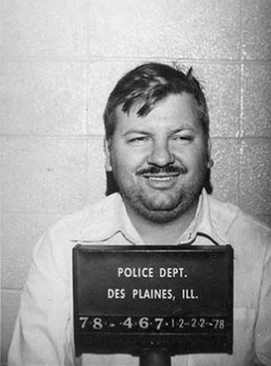John Wayne Gacy docuseries not for faint of heart
Netflix displays serial murders first-hand

John Wayne Gacy poses for his mugshot with a smile, displaying just how cruel and sadistic he was regarding his crimes.
April 27, 2022
Before this weekend, I believed I had become desensitized in a way to heinous crimes, having binge watched nearly every crime documentary and docuseries out to date — crime shows such as “Criminal Minds,” “NCIS” and “Law and Order: Special Victims Unit” — with little to no problem.
I was even able to stomach another “Conversations with a Killer” docuseries for Ted Bundy, one of the most vicious and infamous serial killers of all time.
In the newest installment of the “conversations” series, Netflix has released “Conversations with a Killer: The John Wayne Gacy Tapes” to the platform.
In a series that I thought would take a day to finish, having been a limited series of three episodes released on April 20, it — to my surprise — took me nearly a week to work through.
This was not due to lack of interest or time as finals week approaches; it was completely due to the sheer horror the series contains.
Bundy’s murders were extremely gruesome and villainous, having been called “extremely wicked, shockingly evil and vile,” by his criminal case judge, and the fact that I could watch that docuseries and Zac Efron’s interpretation in a film does not demote the devilish degree of these crimes.
What made this Gacy Netflix docuseries difficult to watch was the repugnant images of 26 bodies being unearthed from the filthy mud of Gacy’s crawl space.
It was simply so dehumanizing.
What also changed the game for the Gacy series was survival testimonies from men, once young boys, who were sexually and physically assaulted by Gacy in his suburban Chicago home, and who were the few who lived to tell their stories.
Additionally, unlike Bundy, Gacy, in great detail, confessed and described his crimes with no emotion or remorse on the tapes, whereas Bundy maintained his innocence until his execution.
Despite his honesty, if that’s what you would consider it, the confessions of Gacy’s murders in such a nonchalant way really revealed just how horrifying callously evil people can truly be.
As the prosecutors and investigators of the documentary described, there were 33 total victims in the evil clutches of Gacy, 26 of whom were buried in his crawl space before he, as he put it, “ran out of real estate.” Eight of the victims have yet to be identified.
I will say, though, Netflix did falsely advertise the series through the photos of Gacy that preview the show, which were for the most part images of him dressed as “Pogo” the clown, a character he dressed up as at some point in his life to entertain others. But this had nothing to do with his crimes and was just a five-minute part of his three-episode series.
Admittedly, according to these images before I knew anything about Gacy, I described him and the series as being about a man who dressed up as a clown and killed boys, because that was the extent of my knowledge given the association with his name along with the photos.
Having stolen 33 lives of young boys and men, though, I question why I had little knowledge of this case, and why Gacy never became the household name that men like Bundy, Charles Manson and Jeffery Dahmer did.
A proposition brought about by gay rights activists in the series was that back in the 1980s, which influences the popularity of the now, homosexuality was still put to shame and silenced, which led to a lot of disbelief of surviving victims coming forward and Illinois’ law enforcement’s lack of interest in finding the missing boys and men.
This was an especially prominent issue in Chicago, where many homosexual males would go to escape unsupportive familial situations, which is where Gacy would prey on many of his victims.
Gacy also selected victims at random, making his MO a great nightmare, but he additionally took advantage of youth looking for hands-on labor, which is where he pooled some of his victims from as well.
Netflix did a great job at tackling this tremendous task, but the series and its content is not for the faint of heart, or the desensitized, as I believed myself to be before streaming this docuseries.
“Conversations with a Killer: The John Wayne Gacy Tapes” is now available for streaming on Netflix.





